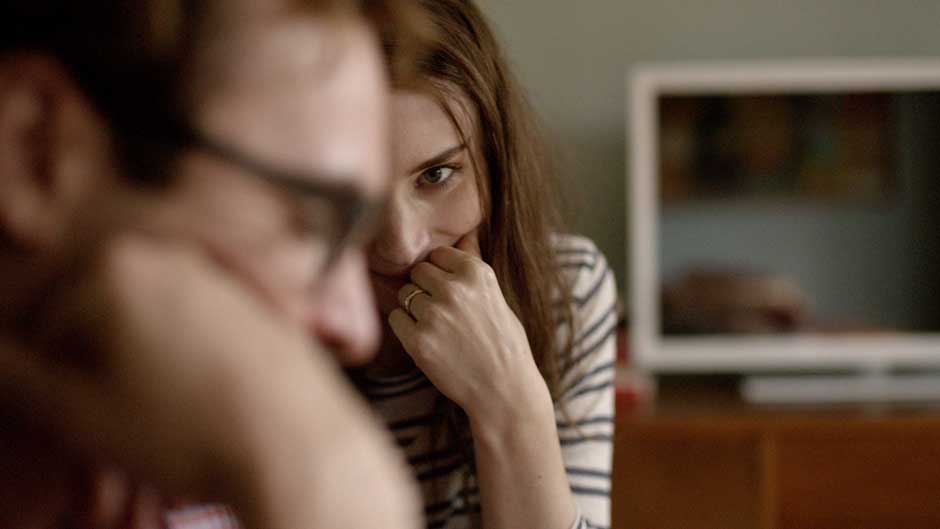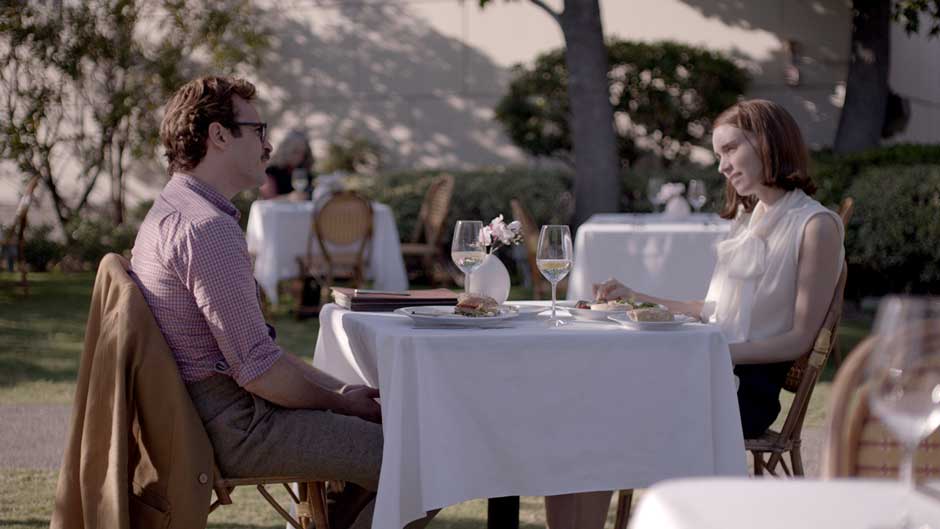The casting of young, beautiful women to play opposite schlumpy men in comedy is a phenomenon we’ve been seeing and talking about at least since Woody Allen’s pioneering advances in the practice. We typically either criticize it as a kind of double standard in film, or seize it as an occasion to discuss real-life mating habits. I’d like to think about it in a different way. I’d like to consider one example of the casting of youth and beauty as an artistic failure that compromises the larger artistic achievement of a film.
I’m talking about Spike Jonze’s movie Her, specifically about Rooney Mara’s small but important role as the soon-to-be ex-wife of the hero, played by Joaquin Phoenix. Lest you haven’t seen it: the setting is the near future, and Phoenix’s character, Theodore Twombly, a professional letter-writer for hire, falls in love with the voice—the very life-like persona—of his computer operating system, which uses an advanced form of artificial intelligence. I admire the possibilities of this premise—which has just won Jonze a Golden Globe for best screenplay—and there are some very good things in the movie. Jonze deftly avoids putting too fine a point on the technical plausibility of the AI conceit. The voice of Samantha, the operating system, performed by Scarlett Johansson, sound very, very much like a real person. On the other hand, her role has, in the beginning, an appropriate ring of ingratiation: Samantha has been designed to anticipate the needs (technical, psychological, and emotional) of her user. Samantha giggles at Theodore’s jokes while making herself useful by sorting his email. So far, so funny. The best moments of the movie are funny ones, in my view, though it ends up pulling away from the comic potential of its conceit and becomes an earnest break-up drama with a swelling piano score.
The film invites us to contemplate the differences between human females and humanoid ones. Theodore, we see, feels defeated by the recent failure of his marriage. He is baffled by the emotional complexities and frustrations of romantic relationships and lacks the optimism to start a new one. A charming, ingenuous, honey-voiced operating system is just his speed, and in a way not so different from the anonymous phone sex (with real people on the other end of the line) that he’s been having to pass the time. He’s also been avoiding signing the divorce papers sent to him by his wife because he just doesn’t want to accept that the marriage is over. But his relationship with Samantha gives him enough of an ego boost to face it. He arranges a lunch meeting with his wife to go over the papers.
The wife, the wife! We are about to get a look at the very source of Theodore’s misery, the marriage that has sent him in flight from human intimacy. The wife, Catherine, turns out to be sublimely beautiful and looks to be about twenty-five. Theodore seems to be in his early forties. This is not an enormous or improbable age difference. But confusingly, we have heard Theodore explain to Samantha that he and Catherine “grew up together,” spent their college and her graduate school years in each other’s company. I found myself distracted, trying to reconcile the stated facts about Catherine with Rooney Mara’s incongruously youthful appearance. There’s also the fact that Catherine has a PhD and very successful career in neuroscience; she has published at least one book. She looks young for all this.
But let’s try not to be too literal-minded. More significant is the way that the actors’ appearances are manipulated for the purposes of the movie. Phoenix appears, if anything, older than he is in real life (which is thirty-nine). His brow is notably furrowed, his hair and mustache flecked with gray. Mara looks, if anything, younger than her age (twenty-eight), and not only younger but artificially flawless. Her skin (unlike Phoenix’s) appears pore-less, perfectly smooth, evenly colored. The word celestial, with all attendant clichés, comes to mind regarding the way that her face is lit in this scene.
What happens between them is that the meeting starts pleasantly—Theodore is confident, Catherine is a little wistful now that he has agreed to sign the papers. Theodore is gratified to see that she still has some residual feelings for him. But then she asks if he is seeing anybody, and he says that he is, and eventually comes around to the fact that Samantha is an operating system. Theodore’s friends seem to accept his relationship with Samantha non-judgmentally (it turns out other people are doing it with their computers too). But Catherine turns scornful; she is a moral link to our own world, our own skepticism and even despair at the prospect of such relationships. Or perhaps Theodore’s virtual relationship merely confirms something that Catherine has come to resent about him: you never could deal with real emotions, she tells him. The atmosphere between them sours.
Advertisement
It could have been a good scene. But one finds oneself dutifully working to suspend disbelief that these two people have spent years locked in love and hate and the daily routines of cohabitation. There’s nothing obtrusively wrong with the writing or acting, but there is not much of a sense of intimacy between Catherine and Theodore, and the main reason for this is that the couple looks mismatched, and the main reason that they look mismatched is that one of them has no visible skin texture.
Having chosen a beautiful young actress, Jonze presents her beauty thoughtlessly, for he doesn’t really know what to do with it other than to signpost in the broadest way: this is a desirable love object. But surely the estranged wife is a certain kind of longed-for love object, to be distinguished from someone you see across the room at a party. Showing Mara in a more naturalistic light would allow her looks to become part of the story. Theodore was married to an unusually attractive woman, we would be able to see. What was it like for him to be married to a woman like that? But we only start asking such questions if Catherine’s appearance seems to us as within the bounds of the visual realism that the film has established for the other characters. In this case, Catherine can look about as beautiful as a beautiful woman in real life—but not more so. If her complexion seems unnaturally perfect, then we know we are looking at a representational convention, one that keeps at bay questions about how human beauty might actually function in life, in relationships. In a crucial way, we the viewers do not know whether Theodore’s wife is beautiful or not, because her appearance has not been admitted into the story. It’s as if her face has been pixelated by a censor.
Her is, you’ll recall, a story about machines and humans and human-like machines. Skin is important. Catherine’s unnatural appearance makes her seem something other than a flesh-bound fellow human with Theodore. She is at some fantastical halfway point between Samantha, the totally disembodied blank field for Theodore’s projections, and Theodore himself in his obviously mortal shell. This seems to me all wrong. There’s a good scene later in the movie in which Theodore takes Samantha on a “double date” with a colleague and his girlfriend. He puts Samantha’s voice on speakerphone and they all chat together. Samantha tells them that she used to be jealous of humans because they had bodies, but then she decided that she was glad not to be anchored in time and space, trapped in a body that was going to die someday. As she talks about space and time and death, the picnickers begin to look uncomfortable. Poor humans. Samantha has touched a nerve. How much better the movie would be—how much more forcefully it could pose its questions—if the former wife, who is so attractive and still so desirable to Theodore, could nonetheless look like a human too.




